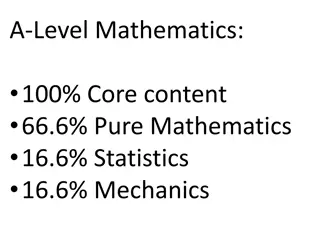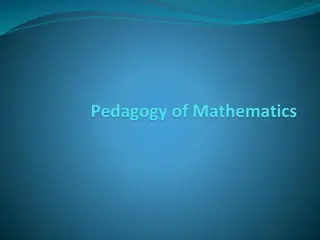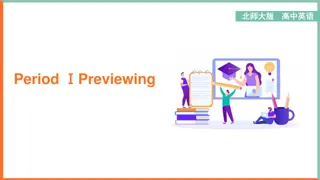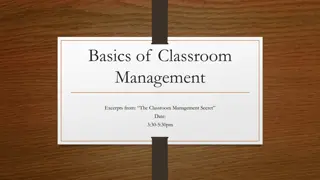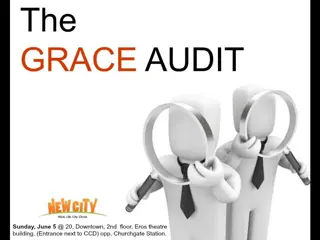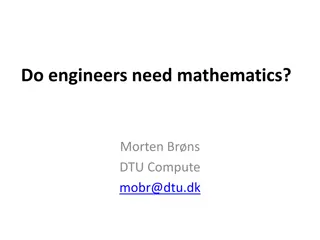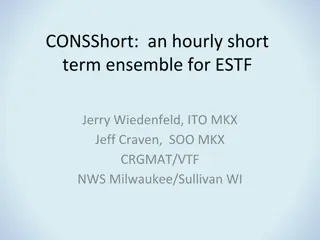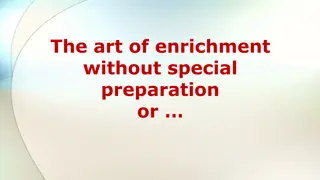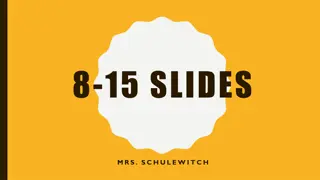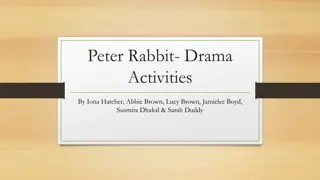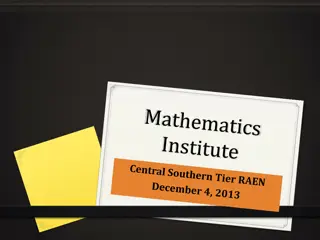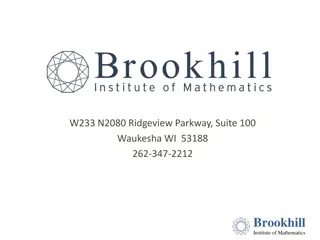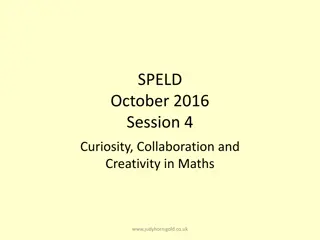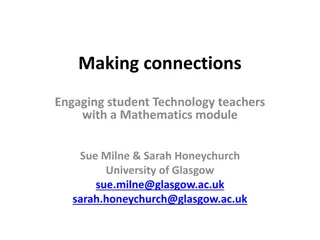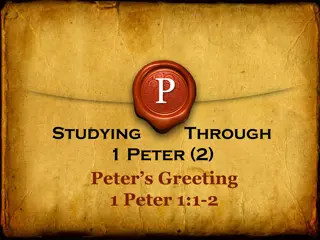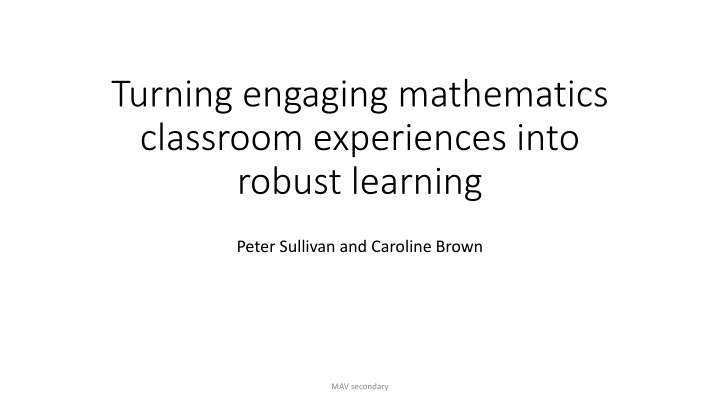
Transforming Mathematics Classroom Experiences for Robust Learning
Explore strategies to engage all students in learning mathematics effectively by converting engaging experiences into flexible learning that can be applied in various contexts. Gain insights on articulating relevant mathematics and using similar tasks for consolidation.
Uploaded on | 0 Views
Download Presentation

Please find below an Image/Link to download the presentation.
The content on the website is provided AS IS for your information and personal use only. It may not be sold, licensed, or shared on other websites without obtaining consent from the author. If you encounter any issues during the download, it is possible that the publisher has removed the file from their server.
You are allowed to download the files provided on this website for personal or commercial use, subject to the condition that they are used lawfully. All files are the property of their respective owners.
The content on the website is provided AS IS for your information and personal use only. It may not be sold, licensed, or shared on other websites without obtaining consent from the author.
E N D
Presentation Transcript
Turning engaging mathematics classroom experiences into robust learning Peter Sullivan and Caroline Brown MAV secondary
Abstract There is now clear evidence that more challenging open-ended tasks engage all students in learning mathematics, including those who learn easily and those who find learning mathematics difficult. The next step is to convert those engaging experiences into flexible learning that can be transferred to other contexts. This session will outline key actions for teachers including articulating the relevant mathematics and the use of similar tasks to follow up and consolidate the learning activated by the initial challenge. MAV secondary
Overview The rationale(s) for trying something different What might the something be? What might the something look like? MAV secondary
The rationale(s) for exploring ways to augment our repertoires Many of the best students (who have been taught using explicit methods) seem to have dodgy outcomes Growth between years 7 and 9 is limited (in the extreme) so we are entitled to question text book approaches Some responses from our research this year that suggests that many students prefer student centred methods Some opinions world wide that argue that the better the task (that the students work on prior to instruction) the better the quality of the learning MAV secondary
Areas of weakness on examiners report (on Vic specialist mathematics) included The quality of students handwriting and the manner in which they set out their mathematics continues to be of concern. Students should be reminded that if an assessor cannot read a student s writing or is not certain as to what it is conveying, marks cannot be awarded. Furthermore, students are expected to set out their work properly. If an assessor is unable to follow a student s working (or reasoning), full marks will not be awarded. Equals signs should be placed between quantities that are equal the working should not appear to be a number of disjointed statements. MAV secondary
not reading the question carefully enough this included not answering the question, proceeding further than required or not giving the answer in the specified form. Students should be reminded that good examination technique includes rereading the question after it has been answered MAV secondary
algebraic skills The inability to simplify expressions often prevented some students from completing a question. Incorrect attempts to factorise, expand and simplify, and the poor use of brackets were common arithmetic skills Difficulty with arithmetic was evident in several questions. The inability to evaluate expressions, especially those involving fractions, was common MAV secondary
showing a given result students need to include sufficient relevant working to demonstrate that they know how to derive the result. MAV secondary
This shape is made with three regular hexagons and three rhombuses Which fraction of the shape is black? 1 1 1 1 3 5 6 4 MAV secondary
40% of the students in Year 7 nationally could answer it correctly 43% of the Year 9 students could answer it MAV secondary
Nat Year 7 Nat Year 9 % correct 11% 20% MAV secondary
It seems that the effectiveness of text book driven approaches are able to be questioned But what might be alternatives? MAV secondary
MULTIPLICATIVE COMPARISONS 1 2 If this represents 3 , draw what represents 1 3 2 (work this out two different ways) MAV secondary
QUESTION 7 QUESTION 7 If this represents 11 3 what represents 1 2 ? A B C D MAV secondary
QUESTION 8 QUESTION 8 Think about question 7 (the one with the squares). I prefer questions we work on in class to be: (choose one option) PRE TEST POST TEST year 7 21% year 8 21% year 7 29% year 8 23% Much harder 67% 69% 65% 67% about the same 11% 386 10% 858 6% 363 10% 768 much easier Total MAV secondary
QUESTION 9 QUESTION 9 Think about question 7 (the one with the squares). I prefer learning how to do questions like question 7: (choose one option) PRE TEST POST TEST year 7 16% year 8 23% year 7 19% year 8 23% By myself Working with other students listening to the teacher's explanations first Total 33% 42% 39% 36% 51% 35% 42% 41% 386 837 365 769 MAV secondary
Only correct responses (year 7 and 8 combined) Much harder about the same much easier By myself 17% 12% 1% Working with other students By listening to the teacher's explanations first 10% 24% 2% 8% 23% 3% MAV secondary
There is agreement that tasks are important in the mathematics classroom, it is through tasks, more than in any other way, that opportunities to learn are made available to the students (Anthony & Walshaw, 2009, p.96). MAV secondary
And those tasks should be challenging Christiansen and Walther (1986) argued that non- routine tasks, because of the interplay between different aspects of learning, provide optimal conditions for cognitive development in which new knowledge is constructed relationally and items of earlier knowledge are recognised and evaluated. MAV secondary
Especially if we wish to go beyond developing fluency Kilpatrick et al. (2001) teachers who seek to engage students in developing adaptive reasoning and strategic competence (or problem solving) should provide them with tasks that are designed to foster those actions. MAV secondary
and the tasks can address the goals of the curriculum National Council of Teachers of Mathematics (NCTM) (2014) noted: Student learning is greatest in classrooms where the tasks consistently encourage high-level student thinking and reasoning and least in classrooms where the tasks are routinely procedural in nature. (p. 17) MAV secondary
So how can we respond? MAV secondary
Cognitive activation tasks require students (prior to instruction) to plan their approach, especially sequencing more than one step; process multiple pieces of information, with an expectation that they make connections between those pieces, and see concepts in new ways; choose their own strategies, goals, and level of accessing the task; spend time on the task and record their thinking; explain their strategies and justify their thinking to the teacher and other students. MAV secondary
Should we start easy and wind it up or start challenging and wind it back? Students benefit when they move from not knowing how to do something to knowing how to do it. In other words, what they have learned is explicit to them. This does not necessarily happen if they are working on the known . When confronted with a task that they cannot do, students need to explore their existing mental structures and schemes, explore links, build connections and identify aspects that are unknown for themselves. MAV secondary
Mindsets offers us a helpful metaphor Dweck (2000) categorized students approaches in terms of whether they hold either growth mindset or fixed mindset MAV secondary
Teachers can change mindsets the things they affirm (effort, persistence, co- operation, learning from others, flexible thinking) the way they affirm You did not give up even though you were stuck You tried something different You tried to find more than one answer the types of tasks posed and the ways that lessons are structured MAV secondary
Getting started zone of confusion four before me representing what the task is asking in a different way such as drawing a cartoon or a diagram, rewriting the question choosing a different approach to the task, which includes rereading the question, making a guess at the answer, working backwards asking a peer for a hint on how to get started looking at the recent pages in the workbook or textbook for examples. MAV secondary
Assumptions students are not reasoning if they are merely repeating an argument developed by someone else the reasoning needs to be their own Students are not solving problems if they have been told what to do thinking takes time and that it happens only when students are working on tasks that they do not know how to solve. MAV secondary
A lesson - Comparing fractions Explain how to work out which is bigger : 2 3 or 201 301 Use two different methods. MAV secondary
Most students were confident that 2 some had difficulty initially trying to justify this. 3 was smaller than 201 301 but MAV secondary
Consolidating Task to establish learning Five groups of 3 fractions to order MAV secondary
Findings from Consolidating Task Having a variety of methods to use when ordering fractions meant that students could select a method that was appropriate to the types of fractions being compared. When the fractions were smaller, the preferred method was a diagram to explain. When the fractions were more difficult, residual thinking or decimals were the preferred method. MAV secondary
Most students seemed to have developed a better understanding of the size of fractions from the ideas that arose in the class discussion. Some of the students who used residual thinking in the consolidating task had not used this for the challenging task but had picked up this idea from the class discussion and then used it. Most students could correctly order the fractions given. MAV secondary
Reflection on using challenging tasks This challenging task took one lesson to complete and the consolidating task was completed for homework. Did not take longer than traditional lesson to do. If the challenging tasks took a little longer we found that we got bang for our buck as students retained the concepts and the ideas seemed to be correctly transferred to new situations more often than seen in the past Challenging tasks seemed to allow students to explore fractions as concepts in their own time and develop ideas for themselves MAV secondary
Having to explain their thinking to others made the misconceptions explicit for both students and their teachers This allowed teachers to address incorrect reasoning and misconceptions in their teaching It allowed students to develop a variety of methods so that they could choose the method based on the types of fractions to be ordered MAV secondary
Semester 2 Examination Students had more confidence to try unfamiliar questions in the Semester 2 examination. No Year 7 students left any questions blank. In Semester 2 Examination in November there was a question on ordering fractions. 21 out of 22 students in the class got it correct. MAV secondary
Semester 2 Reflections: What has worked well for you in Maths this semester? I feel I have learnt so much not only this semester but this whole year. I can t believe how much knowledge I have gained Using different techniques to work things out I have learnt Maths isn t just about methods and answers but is about your learning and how you got the end result. Maths has always been hard for me before but I feel more confident and the results also show my learning. Having class discussions about work we ve done and doing questions together When we work as a class so I can see how other people do operations to extend my skills The different methods have helped me to understand Giving multiple strategies also helped a lot Understanding things myself after not understanding them MAV secondary
Our goal To use what we know about turning points to explore properties of functions. MAV secondary
The first task I used I was not paying attention in my mathematics class. I heard the teacher say that a turning point is at (2, -3) . What might have been the function? (give at least two different possibilities) MAV secondary
What is the mathematics content we hope students will learn (or activate)? How many different approaches might you hope that the students might use? MAV secondary
If you are stuck I was not paying attention in my mathematics class. I heard the teacher say that a turning point is at (0, -3) . What might have been the function? MAV secondary
If you have finished What is a third different strategy for finding a function given a particular turning point? MAV secondary
Turning Point 2 I was not paying attention in my mathematics class. I heard the teacher say that a turning point is at (2, 3) . What might have been the function? (give at least two different possibilities) MAV secondary
Of the students who handed up their sheets, there were 1 student who gave one response to task 1 and only 1 to task 2 9 students who gave one response to task 1 and multiple responses to task 2 5 students who gave multiple responses to both MAV secondary
There were 9 out of 15 students whose responses looked like this MAV secondary
There were many different solutions The formula method The formula method generalised Trig with amplitude of 3 (period /4) Trig with amplitude of 1 Assuming solutions symmetrical around x = 2, then translating the x axis e.g. f(x) = x(x-4) + k f(x) = a (x - 5)2 (x + 1)2 Substituting values into a gradient equation, then anti- differentiating (Chloe) 1 used absolute values MAV secondary
On the rubric Limited Emerging Developed Advanced 10 1 Understanding 3 8 Fluency 5 6 Problem solving 5 4 1 Reasoning MAV secondary


